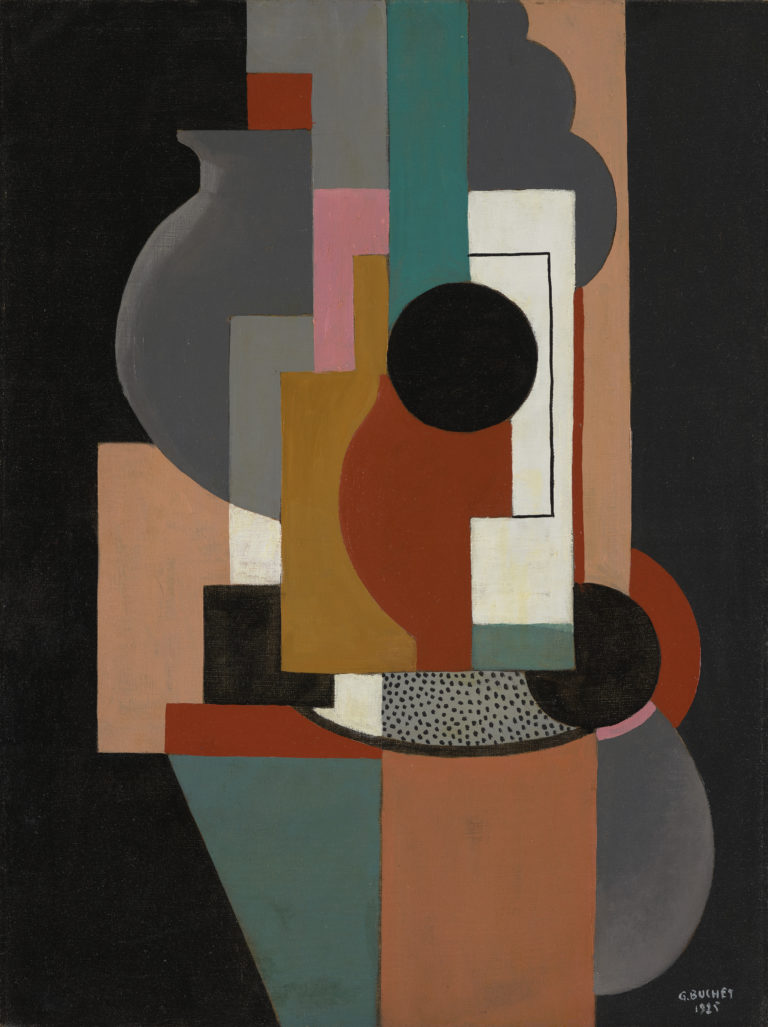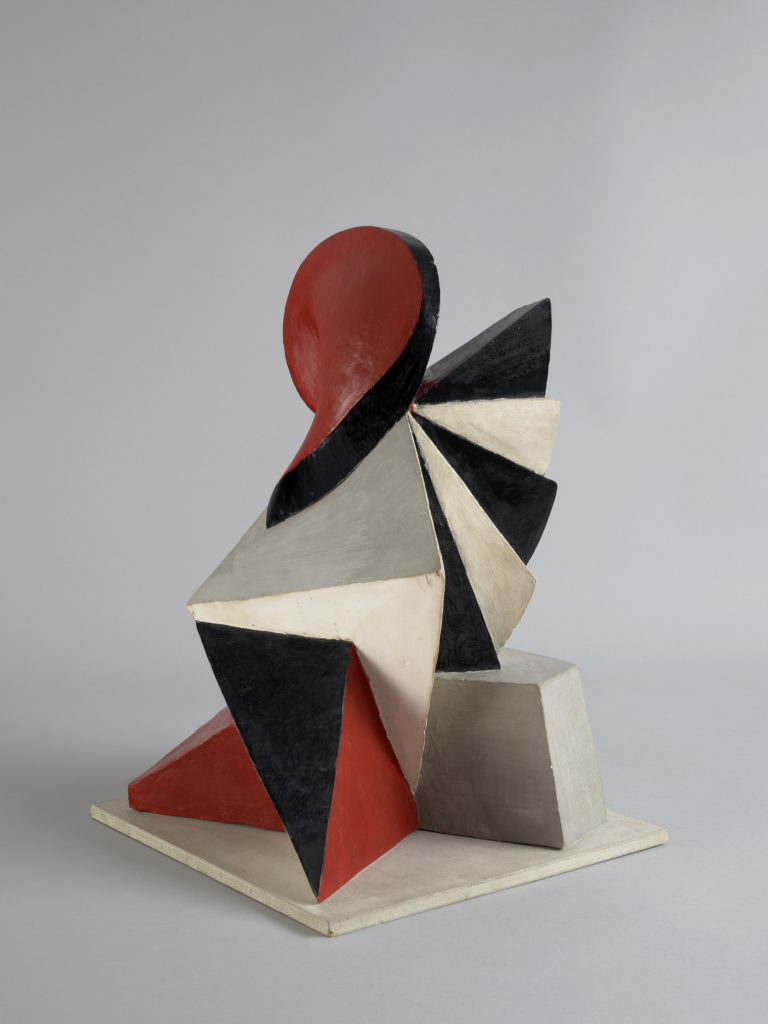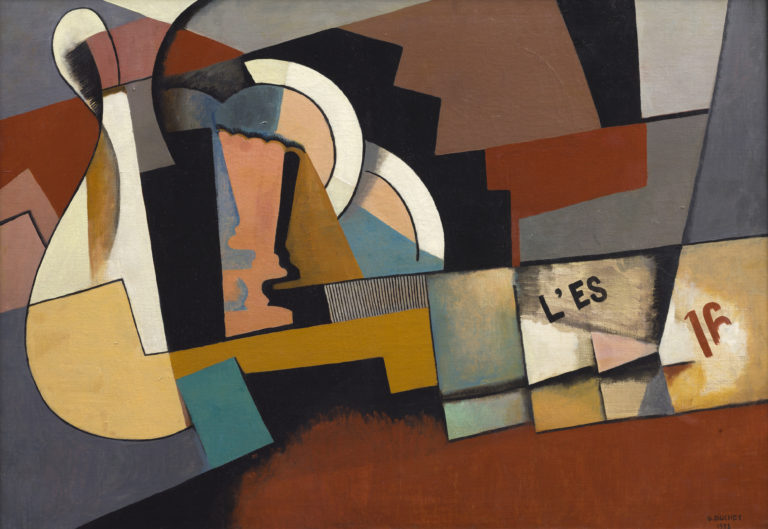Exhibition Guide
Gustave Buchet. Accusé de peindre
Introduction
The show Gustave Buchet. Charged with Painting looks back over the career of the Swiss artist (Étoy, 1888 – Lausanne, 1963), a signal figure of early-20th-century avant- garde movements in Switzerland. Through some one hundred artworks – paintings, sculptures, and pieces from the decorative arts – the exhibition looks to show how Buchet passionately pursued his quest for novel formal solutions.
Starting in the 1910s, Buchet sensed that the future of painting lay not in Geneva and in the wake of Ferdinand Hodler, but in Paris. In the French capital, he found an art scene that was in a state of creative ferment. He eagerly immersed himself in the innovations of Cubism and Futurism, and put them to work in depicting rhythm and movement. In Geneva, he was briefly caught up in Dada.
Buchet evolved in the 1920s towards a flat geometrical painting style that verged on abstraction. Living in Paris during the interwar years, he soon adopted the principles of Purism which Le Corbusier and Amédée Ozenfant were champio- ning. In painting that obeyed the ruler and compass, he developed a personal palette of both forthright and muted colors, and compositions that are remarkably constructed and arranged. Happy to use whatever he could find in the artist’s bag of tricks, he broadened his activities to include sculpture and the decorative arts, turning out designs for the fashion world and the theater.
While Post-Cubism was petering out across Europe, Buchet shifted to a moderate abstraction that posed the challenge of going figurative. Shortly before his return to Lausanne in 1939, he got back in touch with the human, spirituality, and an emotional response to the natural object. Transparency and supple forms prevailed over fragmentation and the interpenetration of pictorial planes. Buchet’s late work would be stamped by a final renewal of his art as he abandoned the diktat of line in favor of a quest for color.
Exhibition curators:
Catherine Lepdor, Chief Curator, MCBA, and Paul-André Jaccard, Fondation Gustave Buchet, Lausanne, with the assistance of Camille de Alencastro, Researcher, MCBA
Gallery 1
Rhythm
Movement
Dynamism
The early years of Gustave Buchet’s career are marked by the artist’s repeated moves from Geneva to Paris and back. In 1910, fresh from the School of Fine Arts, Buchet freed himself of the prevailing influence of Ferdinand Hodler. His teacher Eugène Gilliard had instilled in him the main rules of composition. And Gilliard had also sparked in his student an interest in Maurice Denis, Vincent van Gogh, and even Paul Cézanne, who at the time was denigrated and dismissed. Persuaded that the future of art lay in Paris, the young Buchet embarked for the French capital with his friend Rodolphe-Théophile Bosshard. His painting took on a Symbolist look and colorful and expressive touches.
Returning to Geneva, Buchet married Nelly Bovy-Lysberg and the two led a life that paid little heed to prevailing social conventions. He joined other young painters who, like him, loved bright colors and working in impasto. Together they founded a group in 1914, Le Falot. Under the guidance of Maurice Barraud, they exhibited nudes that terrified the respectable bourgeois public. But Buchet soon came to feel he was working in a dead end.
In the winter of 1916-1917, Buchet was once again in Paris. In Montparnasse, he discovered an exciting art scene that was alive with creative ferment. He became friends with the sculptor Ossip Zadkine, who introduced him to Cubism and Futurism. He took an avid interest in depicting movement, rhythm and “universal dynamism.” Back in Geneva, he exhibited a Futurist interpre- tation of the Entombment at the Concours Diday that sparked controversy. His first solo show in 1919 confirmed his place as the leading practitioner of Futurism.
While the Dada movement was spreading throughout Europe, Buchet was recruited by Tristan Tzara’s friend Walter Serner, who was championing the approach in Geneva. A Dada show with Christian Schad in 1920 and his participation in a Grand Dada Ball brought disgrace and unsettled the artist. He felt he had betrayed art, his art, and quit the city once again for Paris.
Gallery 2
Flatness
Geometry
Precision
Gustave Buchet lived in the French capital during the interwar years. It was a time of rebuilding and trying to return to a stable society. The painter found a renewed sense of purpose by rallying fellow artists for the second Section d’Or. Founded in 1919 by Albert Gleizes, Léopold Survage, and Alexander Archipenko, the group
of artists defended the lasting vitality of Cubism and united its heirs on the march to Abstract Art. Under their influence, Buchet’s painting became flat, geome- trical, and joyfully colorful.
Buchet diversified his activities in the early 1920s. He furnished drawings for advertising, books and newspapers, fashion, and the theater. In 1924, with his future wife Marguerite Robert, he embarked on a new adventure, the Lise Darcy fashion house, designing hundreds of patterns for hats, bags, and cushions. After 1923 his sculpture-paintings show that he took advantage of this experience to rethink his artistic practice.
Starting in 1925, Buchet recentered his energies on easel painting. His new works were taking shape in light of both the modern spirit of Fernand Léger, and Purism, the movement defended by Le Corbusier and Amédée Ozenfant in the review L’Esprit nouveau. He limited his themes to the still life and adopted a highly personal palette of colors in which brownish red ochre dominated, contrasting with shades of white, strong grays, and deep blacks. His “Compositions” are characterized by a heightening of their straight lines and right angles, and the vertical arrangement of objects. The way objects and forms are interlinked alone generates a certain dynamic in the work of art. The “unvarying object” is also joyously combined with the female body. The painting became self-sufficient, a living organism governed by the ideal of a thoroughly mathematical precision.
Gallery 3
Humanism
Light
Color
Following the Crash of 1929 and the start of the Great Depression, Buchet shifted to a moderate type of Abstraction. His forms became softer. He gave up fragmentation and the interpenetration of pictorial planes in favor of juxtaposition and overlaying through transparency. Backgrounds are unified and the range of colors becomes brighter. Objects are arranged in a floating space. Along with his still lifes, Buchet summons the female nude for a spectacular series of torsos reduced to forms that are abstract yet humanized through the incursion of light. Landscapes also took on greater importance, inspired by trips in Normandy, Southern France, and Corsica.
The year 1935 was the start of a new direction. Haunted by a deep need to reconnect with the spiritual, Buchet aspired to greater “humanness” and a more realistic obser- vation of nature. Like many artists of his generation, he aimed to bring painting back to the “grand tradition,” the fine art of creating images, the credible rendering of the materiality of bodies and objects. Step by step, he eliminated arbitrary pictorial planes, enriched the chromatic range of his pigments, and reintroduced chiaroscuro effects and modeling which led to a new sense of volume.
When World War II broke out, Buchet took up permanent residence in Lausanne. He also settled down in terms of his personal life after meeting Georgette Bron, whom he would marry in 1940. In Switzerland his Futurist and Purist output would only be discovered in the early 1950s. Some hailed the direction his art was taking as others blamed him for having opted for a more conventional painting. This then was the context in which Buchet, deeply hurt, published “Accusé de peindre…” (Charged with Painting). He disavowed nothing and asserted his freedom as an artist. Right up to his death in 1963, he would keep his independence of mind and pursue his experimentation with the aim of affirming the primacy of color over line.
Biography
ÉTOY – GENEVA, 1888 – 1920
1888
Birth of Gustave Buchet on
5 June in Étoy, the Canton of Vaud, Switzerland. Six months later, his father, August, the founder of the charitable institution L’Espérance, passes away.
1895
Settles in Geneva with his mother and sister. Classical studies at the Collège Calvin.
1905 – 1908
Studies at the School of Fine Arts in Geneva, where his main teacher is Eugène Gilliard.
1910 – 1911
First stay in Paris, with his friend Rodolphe-Théophile Bosshard. Attends the Académie de la Grande Chaumière. Weds Nelly Bovy-Lysberg.
1912 – 1914
Takes part in national exhibitions, in exhibitions of the Société
des peintres, sculpteurs et architectes suisses (SPSAS, the Geneva section), and the
1st Salon genevois, Galerie Moos.
1914
Founds the artists’ group Le Falot in Geneva with several others, including Maurice Barraud and Otto Vautier-Fils.
1916 – 1917
Second stay in Paris. Attends the Académie de la Grande Chaumière and the open classes at the Académie Colarossi. Becomes friends with Charles Chinet, Jeanne Hébuterne, and Ossip Zadkine.
1918
Exhibits his Futurist works at the Exposition suisse des beaux-arts, Galerie Moos, in Geneva. Competes in the Concours Diday, Geneva (ties for 4th prize with his Mise
au tombeau).
1919
Two solo shows at the Salon Néri, Geneva. Founds the Futurist movement A+D.
1920
Takes part in Dada-Genève. In February, Dadaist exhibition with Christian Schad at the Salon Néri.
PARIS, 1920 – 1939
1920
In mid-March, returns to Paris and settles there. Alexander Archipenko invites him to take part in the traveling show of the second Section d’Or.
1922
First time exhibiting at the Salon des Indépendants. Initial designs in fashion and costumes for the stage.
1923
Meets Marguerite Robert; helps found with her the Lise Darcy fashion house, for which he will produce an unending series of fashion designs.
1924
Exhibits one of his sculpture- paintings at the Salon des Indépendants.
1925
Develops his art of composition in the spirit of Fernand Léger, and the Purism of Le Corbusier and Amédée Ozenfant. Takes part in the Exposition internatio- nale L’Art d’aujourd’hui, designing both the poster and the cover of the accompanying catalogue.
1926
His show at Colette Weil’s Galerie Mantelet is a success. Lise Darcy closes. Travels in Normandy and the following year in the South of France.
1929
Important exhibition at Galerie Zak. Weds Marguerite Robert.
1931
Long stay in Corsica.
1934 – 1936
Various stays in the South of France.
1937
Exhibition at Galerie Drouant, Paris.
1938
Exhibition at Galerie du Lion d’Or, Lausanne. Cruise around Brittany.
1939
Exhibition at the Musée Rath, Geneva. With the declaration of war, settles permanently in Lausanne.
LAUSANNE, 1940 – 1963
1940
Weds Georgette Bron, whom the artist met in Paris in 1933. Renews ties with his family in Étoy.
1941
Starting this year, regularly exhibits at the Salon de
la SPSAS, the Vaud section.
1944
President of Salon 44 at the Musée cantonal des Beaux-Arts of Lausanne (MCBA). Exhibition at Galerie du Capitole, Lausanne.
1945
President of Salon 45 at MCBA.
1946
The nudes that are part of his show at the Musée de Fleurier create a bit of a stir.
1951
1st display of the work from his Futurist and Purist years at Galerie du Capitole, Lausanne.
1952
Exhibition at Galerie de la Paix, Lausanne. Publishes “Accusé de peindre…” (Charged with Painting).
1953
Is commissioned by the Fonds communal des arts plastiques to decorate the firehouse of Lausanne; the eventual piece is done in tilework and installed in 1954.
1958
A retrospective of his work is included in the Salon 58 at MCBA for the artist’s 70th birthday.
1963
Exhibition at Galerie Walcheturm,
Zurich. Passes away on 14 July
in Lausanne. Is buried in the Étoy cemetery.


